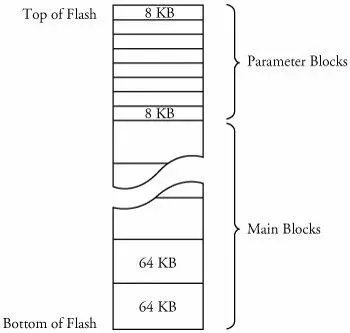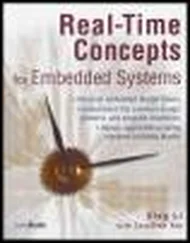For this example, our primary connection to the embedded Linux target is via the RS-232 connection. A serial terminal program is used to communicate with the target board. Minicom is one of the most commonly used serial terminal applications and is available on virtually all desktop Linux distributions.
2.2.2. Starting the Target Board
When power is first applied, a bootloader supplied with your target board takes immediate control of the processor. It performs some very low-level hardware initialization, including processor and memory setup, initialization of the UART controlling the serial port, and initialization of the Ethernet controller. Listing 2-1 displays the characters received from the serial port, resulting from power being applied to the target. For this example, we have chosen a target board from AMCC, the PowerPC 440EP Evaluation board nicknamed Yosemite. This is basically a reference design containing the AMCC 440EP embedded processor. It ships from AMCC with the U-Boot bootloader preinstalled.
Listing 2-1. Initial Bootloader Serial Output
U-Boot 1.1.4 (Mar 18 2006 - 20:36:11)
AMCC PowerPC 440EP Rev. B
Board: Yosemite - AMCC PPC440EP Evaluation Board
VCO: 1066 MHz
CPU: 533 MHz
PLB: 133 MHz
OPB: 66 MHz
EPB: 66 MHz
PCI: 66 MHz
I2C: ready
DRAM: 256 MB
FLASH: 64 MB
PCI: Bus Dev VenId DevId Class Int
In: serial
Out: serial
Err: serial
Net: ppc_4xx_eth0, ppc_4xx_eth1
=>
2.3. Storage Considerations
One of the most challenging aspects of embedded systems is that most embedded systems have limited physical resources. Although the Pentium 4 machine on your desktop might have 180GB of hard drive space, it is not uncommon to find embedded systems with a fraction of that amount. In many cases, the hard drive is typically replaced by smaller and less expensive nonvolatile storage devices. Hard drives are bulky, have rotating parts, are sensitive to physical shock, and require multiple power supply voltages, which makes them unsuitable for many embedded systems.
Nearly everyone is familiar with CompactFlash modules [5] See www.compactflash.org .
used in a wide variety of consumer devices, such as digital cameras and PDAs (both great examples of embedded systems). These modules can be thought of as solid-state hard drives, capable of storing many megabytesand even gigabytesof data in a tiny footprint. They contain no moving parts, are relatively rugged, and operate on a single common power supply voltage.
Several manufacturers of Flash memory exist. Flash memory comes in a variety of physical packages and capacities. It is not uncommon to see embedded systems with as little as 1MB or 2MB of nonvolatile storage. More typical storage requirements for embedded Linux systems range from 4MB to 256MB or more. An increasing number of embedded Linux systems have nonvolatile storage into the gigabyte range.
Flash memory can be written to and erased under software control. Although hard drive technology remains the fastest writable media, Flash writing and erasing speeds have improved considerably over the course of time, though flash write and erase time is still considerably slower. Some fundamental differences exist between hard drive and Flash memory technology that you must understand to properly use the technology.
Flash memory is divided into relatively large erasable units, referred to as erase blocks. One of the defining characteristics of Flash memory is the way in which data in Flash is written and erased. In a typical Flash memory chip, data can be changed from a binary 1 to a binary 0 under software control, 1 bit/word at a time, but to change a bit from a zero back to a one, an entire block must be erased. Blocks are often called erase blocks for this reason.
A typical Flash memory device contains many erase blocks. For example, a 4MB Flash chip might contain 64 erase blocks of 64KB each. Flash memory is also available with nonuniform erase block sizes, to facilitate flexible data-storage layout. These are commonly referred to as boot block or boot sector Flash chips. Often the bootloader is stored in the smaller blocks, and the kernel and other required data are stored in the larger blocks. Figure 2-3 illustrates the block size layout for a typical top boot Flash.
Figure 2-3. Boot block flash architecture

To modify data stored in a Flash memory array, the block in which the modified data resides must be completely erased. Even if only 1 byte in a block needs to be changed, the entire block must be erased and rewritten. [6] Remember, you can change a 1 to a 0 a byte at a time, but you must erase the entire block to change any bit from a 0 back to a 1.
Flash block sizes are relatively large, compared to traditional hard-drive sector sizes. In comparison, a typical high-performance hard drive has writable sectors of 512 or 1024 bytes. The ramifications of this might be obvious: Write times for updating data in Flash memory can be many times that of a hard drive, due in part to the relatively large quantity of data that must be written back to the Flash for each update. These write cycles can take several seconds, in the worst case.
Another limitation of Flash memory that must be considered is Flash memory cell write lifetime. A Flash memory cell has a limited number of write cycles before failure. Although the number of cycles is fairly large (100K cycles typical per block), it is easy to imagine a poorly designed Flash storage algorithm (or even a bug) that can quickly destroy Flash devices. It goes without saying that you should avoid configuring your system loggers to output to a Flash-based device.
NAND Flash is a relatively new Flash technology. When NAND Flash hit the market, traditional Flash memory such as that described in the previous section was referred to as NOR Flash. These distinctions relate to the internal Flash memory cell architecture. NAND Flash devices improve upon some of the limitations of traditional (NOR) Flash by offering smaller block sizes, resulting in faster and more efficient writes and generally more efficient use of the Flash array.
NOR Flash devices interface to the microprocessor in a fashion similar to many microprocessor peripherals. That is, they have a parallel data and address bus that are connected directly [7] Directly in the logical sense. The actual circuitry may contain bus buffers or bridge devices, etc.
to the microprocessor data/address bus. Each byte or word in the Flash array can be individually addressed in a random fashion. In contrast, NAND devices are accessed serially through a complex interface that varies among vendors. NAND devices present an operational model more similar to that of a traditional hard drive and associated controller. Data is accessed in serial bursts, which are far smaller than NOR Flash block size. Write cycle lifetime for NAND Flash is an order of magnitude greater than for NOR Flash, although erase times are significantly smaller.
In summary, NOR Flash can be directly accessed by the microprocessor, and code can even be executed directly out of NOR Flash (though, for performance reasons, this is rarely done, and then only on systems in which resources are extremely scarce). In fact, many processors cannot cache instruction accesses to Flash like they can with DRAM. This further impacts execution speed. In contrast, NAND Flash is more suitable for bulk storage in file system format than raw binary executable code and data storage.
Читать дальше













